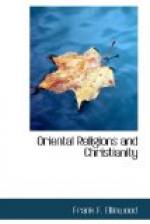Similar to this was the theory which the Hindu Kanada propounded more than two thousand years ago. As translated and interpreted by Colebrook, Kanada taught that two earthly atoms concurring by an unseen and peculiar virtue called “adrishta,” or by the will of God, or by time, or by competent cause, constitute a double atom of earth; and by concourse of three binary atoms a tertiary atom is produced, and by concourse of four triple atoms a quaternary, and so on.[185] Thus the great earth is produced. The system of Lucretius was much the same, though neither Lucretius nor Spencer has recognized any such force as adrishta.[186]
What seems to distinguish Mr. Spencer’s theory is the extension of this evolutionary process to mind and spirit in the development of thought and feeling. He does not say that mind resides in the molecules, but that their movements attend (if they do not originate and control) the operation of the mind. Professor Leconte seems to go farther when he says that “in animals brain-changes are in all cases the cause of psychical phenomena; in man alone, and only in his higher activities, psychic changes precede and determine brain changes."[187] We shall see farther on that Mr. Spencer, in his theory of intuition, admits this same principle by logical inference, and traces even man’s highest faculties to brain or nerve changes in our ancestors. Kanada also held that mind, instead of being a purely spiritual power, is atomic or molecular, and by logical deduction the mental activities must depend on the condition of the molecules.
Ram Chandra Bose, in expounding Kanada’s theory, says: “The general idea of mind is that which is subordinate to substance, being also found in intimate relations in an atom, and it is itself material.” The early Buddhist philosophers also taught that physical elements are among the five “skandas” which constitute the phenomenal soul. Democritus and Lucretius regarded the mind as atomic, and the primal “monad” of Leibnitz was the living germ—smallest of things—which enters into all visible and invisible creations, and which is itself all-potential; it is a living microcosm; it is an immortal soul. These various theories are not parallels, but they have striking similarities. And I believe that Professor Tyndall, in his famous Belfast Address, virtually acknowledges Lucretius as the father of the modern atomic theories. Whether Lucretius borrowed them from India, we shall not stop to inquire, but we may safely assert that modern philosophers, German, French or English, have borrowed them from one or both.
It is not my purpose to discuss the truth or falsity of the atomic theory, or the relation of mind to the movements of molecules in the brain; I simply point out the fact that this is virtually an old hypothesis; and I leave each one to judge how great a degree of light it has shed upon the path of human life in the ages of the past, how far it availed to check the decline of Greece and Rome, and how much of real moral or intellectual force it has imparted to the Hindu race. The credulous masses of men should not be left to suppose that these are new speculations, nor to imagine that that which has been so barren in the past can become a gospel of hope in the present and the future.




